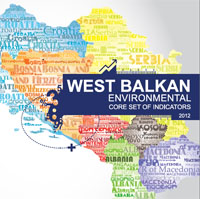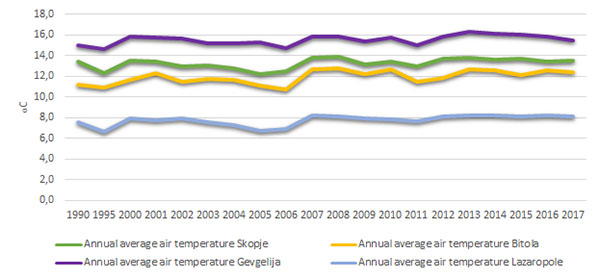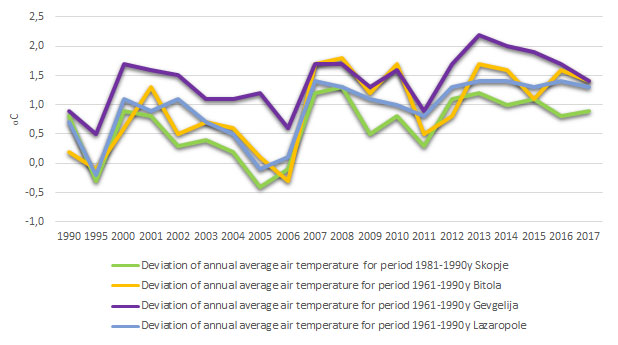| AIR TEMPERATURE |
The indicator shows the annual average air temperature over a given period of time, and deviations from the mean average air temperature in the country and in particular regions.
- Degrees Celsius (°C)
What is the trend in annual average air temperature and its deviation from the meanaverage temperature?
During the reporting period, the positive deviation from the mean average air temperature is recorded and increase in annual average air temperature in all four observed populated places. The deviation from the mean average air temperature for the period 1961 to 1990 ranged between -0.3° and 1.8°C in Bitola, between 0.5°and 2.2°C in Gevgelija and between -0.2°and1.4°C in Lazaropole. In Skopje, the deviation from the mean average airtemperature for the period 1981-1990 ranged between -0.4° and 1.3°C.
Figure 1. Trend in annual temperature at the selected monitoring stations
Figure 2. Average annual deviation from the long-term average temperature at the selected monitoring stations
Data coverage: excel
Source: Hydrometeorological Administration, http://www.meteo.gov.mk/index.php?lang=en
The indicator takes into account data of annual average air temperature from 1990 until 2017, mean average air temperature for the period 1961 to 1990 and the deviation of the annual average air temperature. The data sets which are taken are from Bitola, the second major city,than Gevgelija, site with the highestand Lazaropole, site with the lowest mean average temperature. For Skopje, the mean average air temperature was taken for the period 1981 to 1990.
In Skopje, the annual average air temperature in 2017 recorded increase by 0.9°C compared to mean average air temperature for the period 1981-1990. Warmest year with average annual air temperature of 13.9°C was 2008, with highest deviation of 1.3°C from the mean average airtemperature in the period 1981 to 1990. In Bitola, the average air temperature in 2017 was increased by 1.4°C compared to mean average air temperature for the period 1961-1990y. The warmest year with average annual air temperature of 12.8°C was 2008 with highest deviation of 1.8°C from the meanaverage airtemperature for the period 1961 to 1990.
In Gevgelija, the average air temperature in 2017 was increased by 1.4°C compared to the mean average air temperature for the period 1961-1990. The warmest year with average annual air temperature of 16.3°C was 2013y with highest deviation of 2.2°C from the mean average airtemperature for the period 1961 to 1990. In Lazaropole, the average air temperature in 2017 was increased by 1.3°C compared to the mean average air temperature for the period 1961-1990y. The warmest years with average annual air temperature of 8.2°C were 2007, 2013, 2014 and 2016, with highest deviation of 1.4°C from the mean average airtemperature in the period 1961 to 1990.
- Methodology for the indicator calculation
Air temperature means temperature of ambient air measured in shade (inside meteorological house) at a height of 2 meters. It is measured conventional by standard glass thermometer (mercury or alcohol), specially constructed maximum and minimum thermometers and/or electronic sensor incorporated in the automated weather stations. The main parameters of air temperature for a given location are: daily average temperature, maximum daily and minimum daily temperature.
Data processing of the measured values is consisted of calculating the average air temperatures for a given time period (day, month, year) and/or recording the highest or the lowest values.
Daily average temperature is obtained by air temperatures measured at 07, 14 and 21 hours (local time) using the formula: Тavg = (Т7+Т14+2*Т21)/4
The monthly average air temperature is calculated as sum of the daily average air temperature divided by the number of days in a given month.
The annual average air temperature is calculated as a sum of the monthly average air temperature divided by 12 months.
The highest monthly average air temperature is the highest value of the monthly average air temperature during the given year.
The lowest monthly average air temperature is the lowest value of the monthly average air temperature during the given year.
In the past, meteorological measurements in Skopje were characterized by frequent changes in location. The first meteorological measurementsdate back in 1924 (precipitation station) and measurements as climatological station started in 1944 in old Aerodrom (present location at Jane Sandanski Boulevard) and then the station was relocated at airport Petrovec then and now Alexander the Great. Meteorological station at Zajchev Rid was established in 1978 and has been operating with permanent measurements of meteorological elements and phenomena since then.
According to the surveys carried out in the sector for meteorology so far and results obtained, the Main meteorological station Skopje is more representative for Skopje Valley and wider urban area of the City of Skopje than the station at Alexander the Great airport the main purpose of which are the meteorological measurements for the aviation.
For the above reasons, we propose data from Skopje (Zajchev Rid) as the most relevant coming from a modern meteorological observatory. Based on the aforementioned, the mean average air temperature for the City of Skopje was taken for the period 1981 to 1990.
Legal grounds
Law on Hydrometeorological Activity (Official Gazette of RM no.103/08, 53/11 and 51/15).
The European Union proposed in its climate policy that the global average temperature increase should be limited to not more than 2°C above “pre-industrial” levels
World Meteorological Organization
| Code | Title of the indicator | Compliance with CSI/EEA or other indicators | Classification by DPSIR | Type | Linkage with area | Frequency of publication | |
| MK NI 012 | Air temperature | CSI 012
CLIM 001 |
Global and European temperature | S | B |
|
Annually |







































































